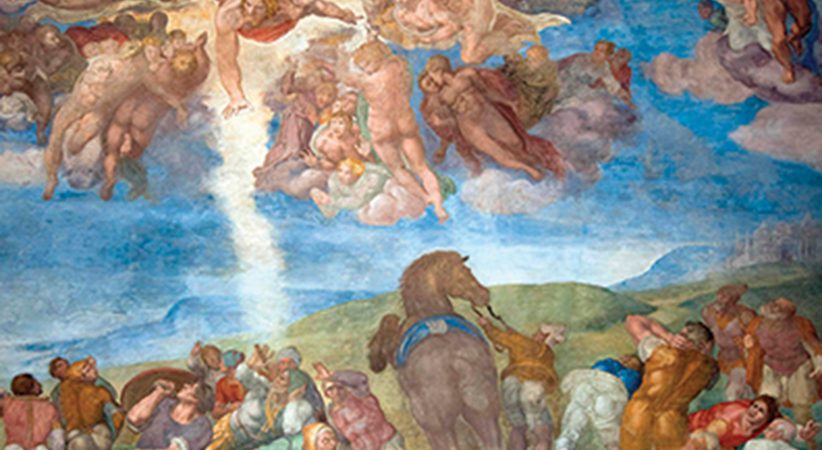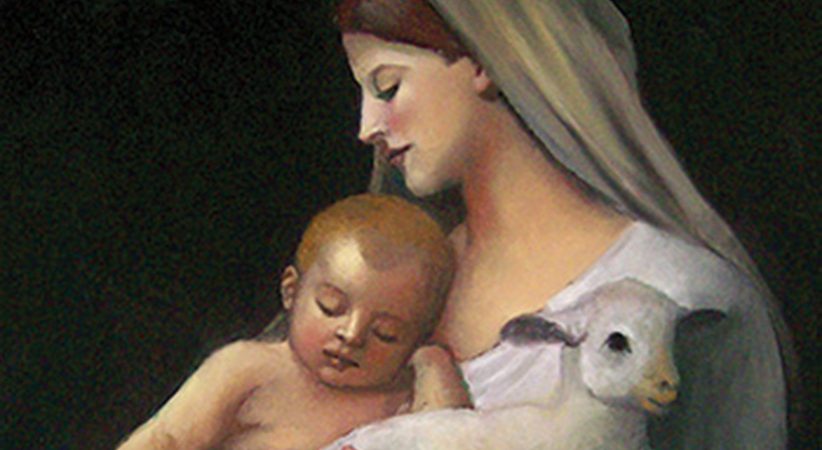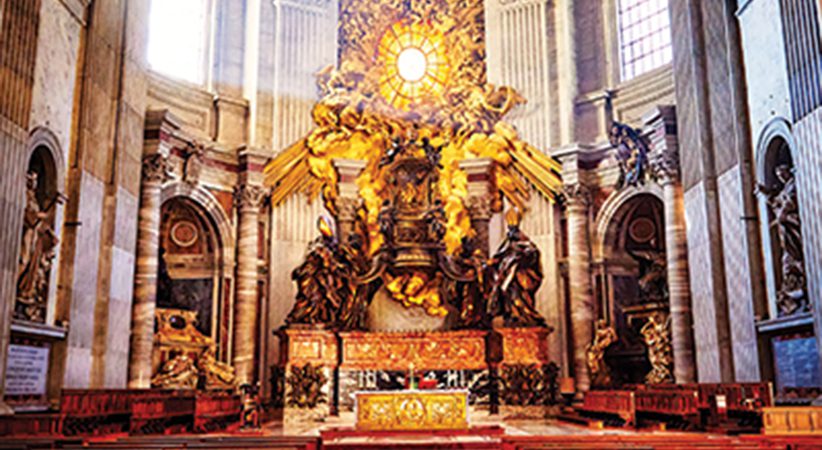The Annunciation and the Priestly Call
Mary, the model disciple and prophet, offers priests a powerful paradigm for pastoral ministry
Father Eugene Hensell Comments Off on The Annunciation and the Priestly Call
The Bible is famous for providing us with stories of faith that are filled with both intrigue and mystery. A classic example is the story of the annunciation to Mary by the angel Gabriel concerning the birth of Jesus. Because these stories were told over and over in the catechetical work of the early Church, they tended to follow a standard structure. For stories on the Annunciation that structure included: 1) the appearance of a divine messenger (angel); 2) expressed bewilderment on the part of the person addressed; 3) the angel’s message; 4) an objection expressed by the person addressed; 5) a confirmation of the message through a sign.
In Luke’s Gospel, there are two annunciation stories placed side by side. The first is the annunciation to Zechariah concerning the birth of John the Baptist (cf. Lk 1:5-25). The second is the annunciation to Mary regarding the birth of Jesus (Lk 1:26-38). A careful reading of these stories shows that Jesus is superior to John the Baptist in all ways. This emphasis is one that Luke intends to make. Our concern, however, will focus primarily on the angel Gabriel’s annunciation to Mary.
God’s Saving Action
The first thing to notice in this story is that the magnificent message of God’s saving action takes place within the context of the ordinary and is totally unexpected. The town of Nazareth is mentioned nowhere in the Old Testament, and it was famous for nothing. Mary is a virgin betrothed to a man named Joseph. These were very common names and betrothal was the name for the legal aspect of getting married. The couple did not live together as man and wife until after the wedding ceremony, generally a year after official betrothal. So reference to Mary being a virgin would be expected. All of this would be ordinary daily living and by no means newsworthy. Joseph’s only extraordinary claim is that he is from the house of David, which ultimately will indirectly give Jesus access to that same house.
Into this environment of ordinary daily life bursts the angel Gabriel (meaning: “God is my strength”). He addresses Mary directly with the greeting: “Hail, favored one! The Lord is with you.” Mary, of course, has no background or expectation that might allow her to understand what this angel is saying or why he is saying it.
Luke continues to keep Mary rooted in the ordinary by describing her reaction to the angel’s greeting as being “greatly troubled” by what he said. She has every right to be troubled. These words and their ramifications will require a good bit of pondering in an attempt to grasp their meaning. The angel Gabriel apparently detects the consternation his words have caused Mary, and he quickly seeks to calm her with the admonition, “Do not be afraid.” Anytime in the Bible a person comes face to face with the divine reality of God, no matter what form it might take, the result is always fear. The tremendous awesomeness of God and God’s messengers are totally overwhelming even when the message itself is positive.

The angel Gabriel’s message to Mary begins with the affirmation that she has found favor with God. However, once she hears what that means she might well question how it could add up to something positive for her and the man to whom she is betrothed. Gabriel’s explanation of how Mary has found favor with God is aimed more at the reader of this Gospel than to Mary. It expresses Luke’s Christological understanding of Jesus.
Most of this would be incomprehensible to Mary. First of all she is to conceive and bear a son and name him Jesus (meaning: “Jeshua saves”). Next Gabriel indicates the special status of this child: “He will be great and he will be called Son of the Most High.” This implies that Jesus will be the Son of God. As such he will inherit the throne of David his father whose house and the kingdom will have no end (cf. 2 Sm 7:14-16). The meaning of all this is still debated by learned scholars. And Mary makes no pretense of understanding any of it. Her response is exactly what we would expect from her. She questions how she could be favored with a child since she has never had relations with a man. She is a virgin. Such questioning gives Gabriel another opening for an even deeper and more complicated layer of Christology. The conception will take place through the Holy Spirit and the overshadowing of the power of the Most High. The child will be called holy, the Son of God. And all of this leaves Mary literally speechless.
The sign that the angel Gabriel offers Mary as confirmation that these miraculous movements will indeed happen is in reference to her relative Elizabeth. This very faithful but barren woman has, in fact, conceived a son in her old age. Gabriel seems to know that Mary might find the reference to Elizabeth less than convincing. His final words to Mary are a profound combination of hope and faith: “For nothing will be impossible for God.” Without claiming any depth of understanding or having any clear insight as to where all this might lead, Mary accepts this message from the angel Gabriel and declares herself to be the handmaid of the Lord. Because of Mary’s acceptance of the divine message from Gabriel, she is considered in Christian tradition to be the model disciple rooted in faith and hope.
Prophetic Call
At this point, I would like to offer a slightly different perspective on Mary based on the same text of Luke 1:26-38. While this passage structurally fits the requirements for an annunciation story, I would like to suggest that these same points also fit the traditional Old Testament prophetic call narrative. These narratives contain the following points: 1) divine confrontation; 2) introductory greeting; 3) commission; 4) objection by the one called; 5) reassurance; 6) sign of confirmation.
A good example of this is the call of Isaiah (cf. Is 6:1-10). Notice how similar these elements are to the ones included in an annunciation story. Could it be that Mary is not only the recipient of a divine announcement, but that below the surface of that announcement is the call to be a prophet?
After the angel Gabriel had departed from Mary, she immediately went to visit her relative Elizabeth (cf. Lk 1:41-45). Mary, however, says nothing, but Elizabeth, filled with the gift of the Holy Spirit, praises Mary and the child she is carrying. When Mary finally speaks, she proclaims the greatness of the Lord in a passage that has come to be known as the Magnificat (Lk 1:46-55). There Mary prophetically proclaims a future revolution that is going to take place at the hands of her son. He will bring to fulfillment the promises made to Abraham and his descendants. He will turn upside down the world as it was then known. Mary is indeed a servant of the Lord, but more in terms of a prophet than a handmaid.
Aspects of Mary’s Call
Furthermore, let me suggest three aspects of Mary’s annunciation-prophetic call that deserve our attention. First is the admonition, “Do not be afraid.” Her call will put her in situations where fear and confusion will reign supreme. She will constantly have more questions than answers as her son grows into adulthood and begins to execute his divine mission.
The reason why she need not be afraid in such circumstances is that she is favored by God, and this is the second aspect deserving our attention. This is the same favor that Jesus experienced as he matured. At the conclusion of the story of the adolescent Jesus being found in the Temple we are told that “the favor of God was upon him” (Lk 2:40). To be favored by God is to have God’s divine approval. Such approval carries with it the grace of God’s protection. God delights in those he has called and watches out for the ones he commissions.
The third and final aspect contained in Mary’s annunciation-prophetic call counters the overwhelming sense of weakness and feelings of incompetence in the face of what God demands. The task of bearing God’s Son and proclaiming God’s Word seems impossible. If it were up to Mary alone such impossibility would be a given. But here is the final admonition she receives: “For nothing will be impossible for God.” To believe this demands a deep faith that allows Mary to accept this divine announcement and prophetic calling. It requires a trust that says God keeps the promises hehas made, regardless of what appears on the surface of things.
Priestly Relevance
Finally, let me suggest that the three elements holding together Mary’s annunciation-prophetic call are very relevant to a contemporary understanding of priesthood as it is lived out in today’s pastoral ministry. In a real way this is what the Church wants to say to every newly ordained priest as well as to those priests with many years of pastoral experience: 1) Do not be afraid; 2) You have found favor with God; 3) Nothing will be impossible for God.
When the Church announces that she is calling a person to the priesthood, implicit in that annunciation is the call to prophesy, to announce the Word of God by what the priest says and, most especially, by how the priest lives out his life.
Such an announcement and calling does not require perfection. It requires trust and deep faith in God. The longer a priest serves the Church in pastoral ministry the more he realizes just how essential those three elements are. This is what Pope Francis has been proclaiming to priests and bishops since the day of his election. He is a model for what that looks like, lived out in the concrete. Mary the model disciple and prophet offers priests a powerful paradigm for pastoral ministry. It can be summarized in the words of Mary herself. “May it be done to me according to your word” (Lk 1:38).
FATHER EUGENE HENSELL, OSB, is a monk of St. Meinrad Archabbey in St. Meinrad, Indiana, and an associate professor of Scripture at St. Meinrad Seminary and School of Theology.
………………………………………………………………………………………………………………………………………………………..
Pope Francis: “Mary Is the Model of Every Vocation”
In his address to the faithful on March 25, 2019, outside the basilica that houses Mary’s Holy House in Loreto, Italy, Pope Francis used the occasion to sign Christus vivit (“Christ Lives”) and spoke of the three moments that marked the synod leading to the apostolic exhortation to young people: 1) listening to the Word — plan of God; 2) discernment; and 3) decision.
“The first moment, that of listening, is manifested by those words of the Angel: ‘Do not be afraid, Mary; for you have found favor with God,’” the pope said. “It is always God who takes the initiative to call to his following.”
He added, “The second moment typical of every vocation is discernment, expressed in Mary’s words: ‘How will this be?’ (v. 34). Mary does not doubt: her question is not a lack of faith, rather it expresses precisely her desire to discover the ‘surprises’ of God. In her there is attention to grasping all the demands of God’s plan for her life, to know it in all its facets, to make her own collaboration more responsible and more complete.
“Decision is the third step that characterizes every Christian vocation, and is made explicit in Mary’s answer to the angel: ‘Let it be to me according to Your word.’ Her ‘yes’ to God’s plan of salvation, put into effect by means of the Incarnation, is the consignment to him of all her life. It is the ‘yes’ of full trust and total availability to God’s will.”
Speaking to an audience of Capuchins, young people and citizens of Loreto, Pope Francis said, “Mary is the model of every vocation and the inspirer of every vocational pastoral care: the young who are seeking or questioning themselves about their future may find in Mary she who helps them to discern God’s plan for them and the strength to adhere to it.”
……………………………………………………………………………………………………………………………………………………………





